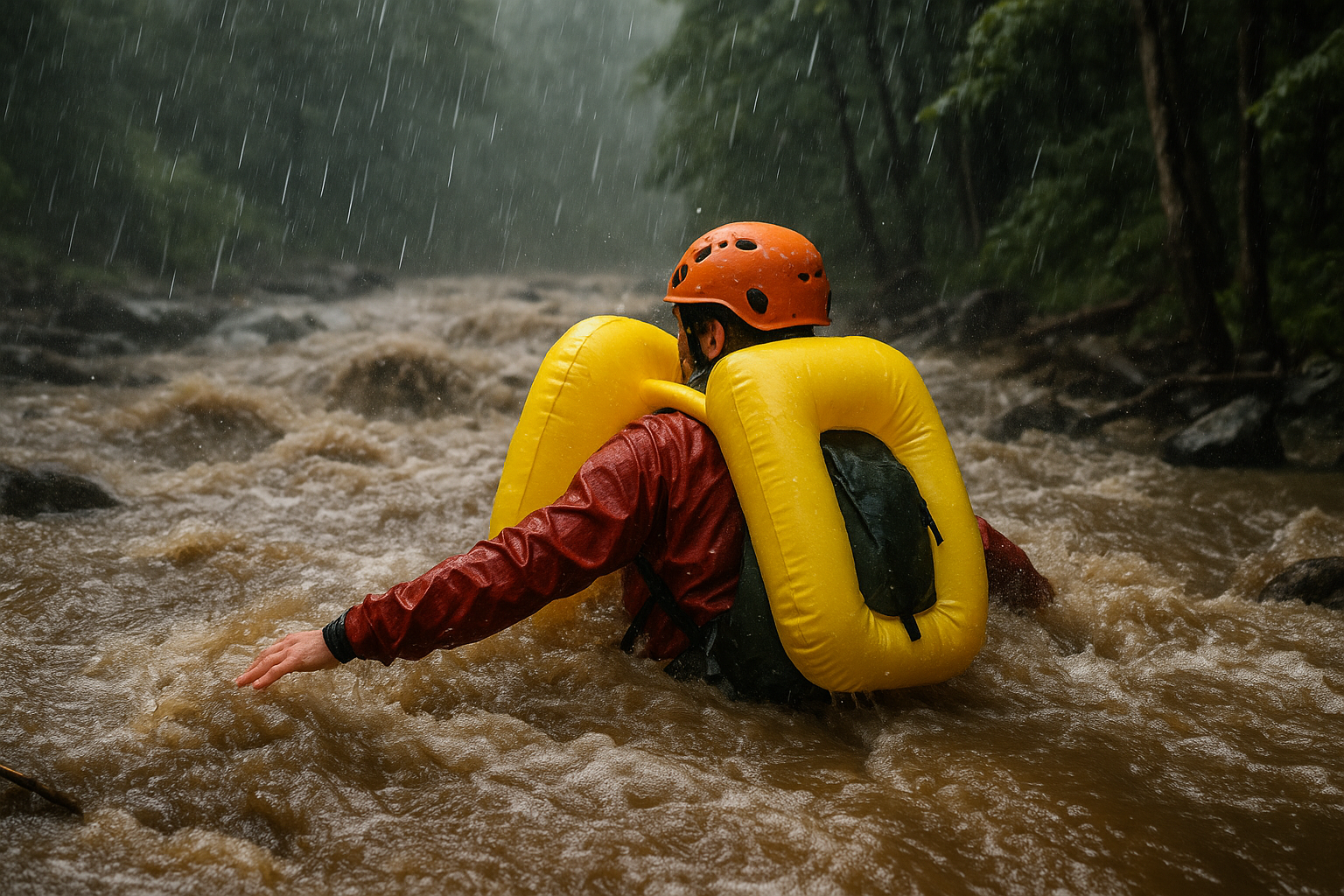The Sky Opens, the River Rises—And You’re Trapped
You were trekking through a canyon, maybe enjoying a gentle stream crossing. The skies darkened, and within minutes, the stream became a raging torrent. Floodwaters surged in from upstream, cutting off your return path. The only way out is through—or over—the rising tide.
In this critical situation, improvised flotation can save your life. It’s not about fancy rescue gear or waiting for help. It’s about having inflatable tools packed or knowing how to create them in the field.
1️⃣ Compact Inflatable Gear: The Essentials That Fit in Your Pack
Forget bulky life vests or kayaks—you need survival gear designed for sudden floods, packed small, and inflated fast.
- Ultralight Packraft (like the Alpacka Scout, Amazon): Weighing under 5 lbs, these inflatable rafts roll into a compact bundle and can be deployed in minutes. Perfect for crossing sudden floodwaters or creating a stable platform.
- Inflatable Dry Bags (like the Sea to Summit Evac Compression Dry Sack, Amazon): Not just for keeping gear dry—fill with air, seal tightly, and they become makeshift floatation aids.
- Inflatable Seat Cushions (like Therm-a-Rest Lite Seat, Amazon): Small enough to fit in your pocket, these can be inflated to provide extra buoyancy.
🎒 Field Tip: Keep a mini pump or learn how to inflate by mouth in the field. Practice beforehand—you won’t have time to read instructions during a flood.
2️⃣ Improvised Inflatable Hacks When You Have No Gear
Caught without packrafts or inflatable bags? Think creatively:
- Trash Bags and Pack Liners: Fill large plastic bags with air, twist and knot them, and secure inside a backpack or tied to your body for buoyancy.
- Empty Water Bottles: Cap tightly and bundle together in mesh bags or clothing to create makeshift flotation.
- Foam Pads and Sleeping Mats: Roll them tightly and secure with cordage to form a flotation cylinder.
🔥 Critical Field Hack: Even a lightweight sleeping pad or foam roll can support your upper body if properly secured.
3️⃣ Stealth and Low-Visibility Flotation in a Crisis
In regions where you might face human threats or need to stay low-profile during a flood evacuation:
- Opt for Olive Drab or Coyote Brown Inflatable Gear: Avoid bright colors that attract attention in sensitive situations.
- Silent Deployment: Practice inflating gear silently and quickly. Avoid loud pumps or noisy packaging.
- Blend with Environment: Choose gear with matte finishes and natural tones. Even in water, visibility can attract attention.
🌲 Field Hack: Use natural debris (leaves, sticks) to disguise your flotation device if you must pass unnoticed.
4️⃣ Key Considerations for Floodwater Survival
Floodwaters aren’t just about depth—they’re about speed, debris, and contamination.
- Strap Down Gear: Secure all loose items with cordage or bungee straps. Floating debris can sweep away unsecured packs.
- Avoid Metal Buckles: These can catch on obstacles underwater. Opt for plastic or breakaway buckles.
- Know the Current: If you’re entering floodwaters, identify the least turbulent sections. Avoid V-shaped currents or areas with visible debris.
🚨 Field Rule: Never jump into floodwaters unless absolutely necessary. Test flotation devices in shallow, slower-moving sections first.
5️⃣ Must-Have Inflatable Survival Gear (Amazon-Available)
- Alpacka Scout Packraft: Compact, durable, and fast to deploy.
- Sea to Summit Evac Dry Compression Sack: Dual-use as dry storage and emergency flotation.
- Therm-a-Rest Lite Seat: Tiny but effective for buoyancy in a pinch.
- Earth Pak Dry Bag: Seals gear and doubles as a buoyant aid when filled with air.
6️⃣ Advanced Flood Escape Techniques
- Build a Raft from Packs and Gear: Lash multiple inflated dry bags, foam pads, and sealed bottles with paracord to create a stable platform.
- Use Trekking Poles or Branches for Stability: In swift currents, a pole can help you balance and test depth.
- Diagonal Movement: Never fight directly against the current. Move diagonally downstream toward a stable exit point.
💡 Pro Trekker Insight: Practice building emergency flotation devices during non-emergency hikes. Familiarity with your gear and technique saves precious time.
7️⃣ When to Evacuate—and When to Hunker Down
If floodwaters rise rapidly and you’re surrounded by steep terrain, sometimes climbing to higher ground is safer than attempting a crossing. But if your location becomes untenable:
- Deploy Inflatable Gear: Create buoyancy and prepare for controlled entry into the water.
- Aim for Natural Obstacles: Downed trees, boulders, or eddies can provide temporary shelter from the current.
- Signal for Help: Use a compact signal mirror or whistle if safe to do so.
🚨 Life-Saving Rule: Always stay attached to your pack if it contains flotation gear. In swift water, separation can be fatal.
8️⃣ Real-World Field Story
“Last year during a solo trek, I got caught by a flash flood in a canyon. My ultralight packraft and inflatable dry bags kept me afloat for hours until the waters receded. Without them, I’d have been pinned against the rocks with no way out.”
Conclusion: Buoyancy Buys Time—Be Ready
When a day-trek turns into a flood survival scenario, every second counts. Compact inflatable gear can mean the difference between floating to safety and being swept away. Prepare with multi-use gear, practice deployment, and know how to improvise if caught unprepared.
In the wilderness, floodwaters don’t wait for you to plan. Float or be swept away.

